MaryAnn Bernal's Blog, page 206
January 5, 2015
Tomb of Previously Unknown Pharaonic Queen Found
 The tomb of Princess Shert Nebti in Abu Sir, south of Cairo, dating from around 2,500 BC and discovered in 2012.
The tomb of Princess Shert Nebti in Abu Sir, south of Cairo, dating from around 2,500 BC and discovered in 2012.Czech archaeologists have unearthed the tomb of a previously unknown queen believed to have been the wife of Pharaoh Neferefre who ruled 4,500 years ago, officials in Egypt said Sunday.
The tomb was discovered in Abu Sir, an Old Kingdom necropolis southwest of Cairo where there are several pyramids dedicated to pharaohs of the Fifth Dynasty, including Neferefre.
The name of his wife had not been known before the find, Antiquities Minister Mamdouh al-Damaty said in a statement.
New Pharaoh Found in Egypt He identified her as Khentakawess, saying that for the "first time we have discovered the name of this queen who had been unknown before the discovery of her tomb".
That would make her Khentakawess III, as two previous queens with the same name have already been identified.
Her name and rank had been inscribed on the inner walls of the tomb, probably by the builders, Damaty said.
"This discovery will help us shed light on certain unknown aspects of the Fifth Dynasty, which along with the Fourth Dynasty, witnessed the construction of the first pyramids," he added.
Miroslav Barta, who heads the Czech Institute of Egyptology mission who made the discovery, said the tomb was found in Neferefre's funeral complex.
Top Archaeological Finds Expected in 2015
"This makes us believe that the queen was his wife," Barta said, according to the statement.
An official at the antiquities ministry said the tomb dated from the middle of the Fifth Dynasty (2994-2345 BC).
Archaeologists also found around 30 utensils, 24 made of limestone and four of copper, the statement added.
Discovery News
Published on January 05, 2015 07:29
History Trivia - Edward the Confessor dies
January 5

1066, Edward the Confessor, King of England, died. Edward was the son of Æthelred the Unready and Emma of Normandy, was one of the last Anglo-Saxon kings of England and is usually regarded as the last king of the House of Wessex, and ruled from 1042 to 1066.

1477 Charles the Bold was killed at the Battle of Nancy at which time Burgundy became part of France.

1554 A great fire occurred in Eindhoven, Netherlands.

1531 Pope Clemens VII forbade English king Henry VIII to re-marry.


1066, Edward the Confessor, King of England, died. Edward was the son of Æthelred the Unready and Emma of Normandy, was one of the last Anglo-Saxon kings of England and is usually regarded as the last king of the House of Wessex, and ruled from 1042 to 1066.

1477 Charles the Bold was killed at the Battle of Nancy at which time Burgundy became part of France.

1554 A great fire occurred in Eindhoven, Netherlands.

1531 Pope Clemens VII forbade English king Henry VIII to re-marry.

Published on January 05, 2015 03:00
January 4, 2015
History Trivia - Ethelred of Wessex badly defeated by a Danish invasion army
January 4

46 BC Julius Caesar defeated Titus Labienus in the Battle of Ruspina.

48 BC, Julius Caesar arrived in Greece in pursuit of his rival, Pompey, whom he later defeated at Pharsalus.
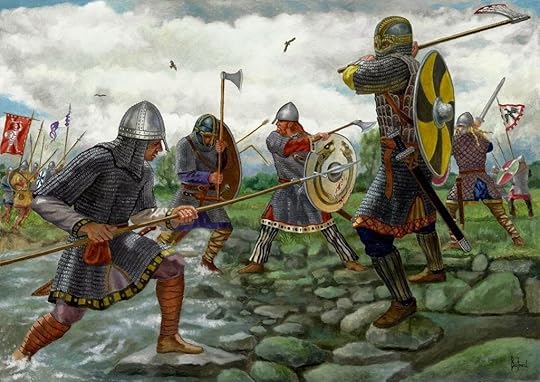
871, at the Battle of Reading Ethelred of Wessex fought and was badly defeated by a Danish invasion army.

1698 most of the Palace of Whitehall in London, the main residence of the English monarchs, was destroyed by fire.


46 BC Julius Caesar defeated Titus Labienus in the Battle of Ruspina.

48 BC, Julius Caesar arrived in Greece in pursuit of his rival, Pompey, whom he later defeated at Pharsalus.

871, at the Battle of Reading Ethelred of Wessex fought and was badly defeated by a Danish invasion army.

1698 most of the Palace of Whitehall in London, the main residence of the English monarchs, was destroyed by fire.

Published on January 04, 2015 03:30
January 3, 2015
British metal detectorist finds hoard of Anglo-Saxon coins worth $2 million
BY Lee Moran
NY Daily News
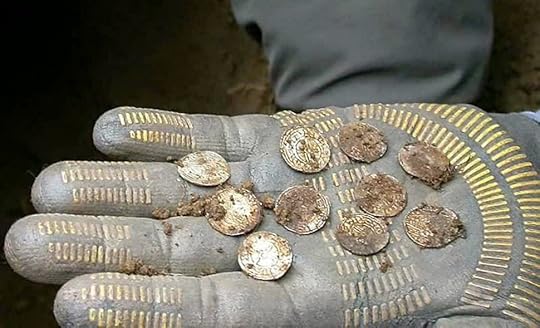
Paul Coleman, 59, could barely afford to fuel his car to go on the trip with the Weekend Wanderers Detecting Club. But after finding over 5,000 ancient coins in Aylesbury, he says he'll never have to work again.
"This find means I will never have to work again," Coleman said afer discovering the loot. Coleman, a father of two and grandfather of four, almost skipped the detecting trip because he could barely afford to put gas in his car.
A cash-strapped British treasure hunter was given the perfect early Christmas present — after he unearthed a buried hoard of Anglo-Saxon coins worth an eye-popping $2 million.
Amateur metal detectorist Paul Coleman was scouring farmland near Aylesbury, Bucks., on Dec. 21 when he made the astonishing discovery, reports the Daily Mirror.
It's one of the biggest finds ever made in Britain.
"I found a piece of lead and thought it was junk. But I looked back in the hole and saw one shiny coin. Then I lifted a larger piece of lead and saw row upon row of coins stacked neatly," he said.
"By that point the excitement had built up and I was grinning from ear to ear," he added.
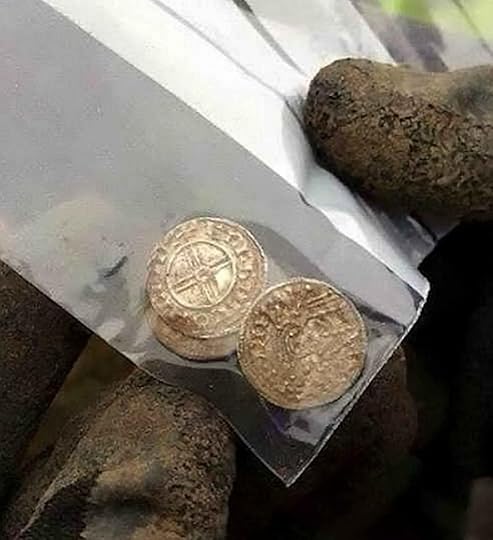 The coins are believed to be from the reigns of of Ethelred the Unready (978 - 1016) and King Canute (1016 - 1035).Experts think the 5,251 coins, hidden in a lead box two feet underground, could have been buried after the 1066 Battle of Hastings to protect them from Norman invaders.
The coins are believed to be from the reigns of of Ethelred the Unready (978 - 1016) and King Canute (1016 - 1035).Experts think the 5,251 coins, hidden in a lead box two feet underground, could have been buried after the 1066 Battle of Hastings to protect them from Norman invaders.
They are each valued at $390.
The metallic money hailed from the reigns of Ethelred the Unready (978 - 1016) and King Canute (1016 - 1035).
Granddad-of-four and dad-of-two Coleman, 59, said the find — the sale of which he will share with the landowner and metal detectorist friends — had changed his life.
Weekend Wanderers Detecting Club/SWNS.comAnd he revealed that he'd almost not gone on the Weekend Wanderers Detecting Club hunt because he couldn't afford to fill his car with gasoline.
"This find means I will never have to work again — it's a massive weight off my mind," the Southampton resident said.
The coins have since been taken to the British Museum to be identified. A coroner will rule it is treasure before bidding can be opened on the haul.
NY Daily News

Paul Coleman, 59, could barely afford to fuel his car to go on the trip with the Weekend Wanderers Detecting Club. But after finding over 5,000 ancient coins in Aylesbury, he says he'll never have to work again.
"This find means I will never have to work again," Coleman said afer discovering the loot. Coleman, a father of two and grandfather of four, almost skipped the detecting trip because he could barely afford to put gas in his car.
A cash-strapped British treasure hunter was given the perfect early Christmas present — after he unearthed a buried hoard of Anglo-Saxon coins worth an eye-popping $2 million.
Amateur metal detectorist Paul Coleman was scouring farmland near Aylesbury, Bucks., on Dec. 21 when he made the astonishing discovery, reports the Daily Mirror.
It's one of the biggest finds ever made in Britain.
"I found a piece of lead and thought it was junk. But I looked back in the hole and saw one shiny coin. Then I lifted a larger piece of lead and saw row upon row of coins stacked neatly," he said.
"By that point the excitement had built up and I was grinning from ear to ear," he added.
 The coins are believed to be from the reigns of of Ethelred the Unready (978 - 1016) and King Canute (1016 - 1035).Experts think the 5,251 coins, hidden in a lead box two feet underground, could have been buried after the 1066 Battle of Hastings to protect them from Norman invaders.
The coins are believed to be from the reigns of of Ethelred the Unready (978 - 1016) and King Canute (1016 - 1035).Experts think the 5,251 coins, hidden in a lead box two feet underground, could have been buried after the 1066 Battle of Hastings to protect them from Norman invaders.They are each valued at $390.
The metallic money hailed from the reigns of Ethelred the Unready (978 - 1016) and King Canute (1016 - 1035).
Granddad-of-four and dad-of-two Coleman, 59, said the find — the sale of which he will share with the landowner and metal detectorist friends — had changed his life.
Weekend Wanderers Detecting Club/SWNS.comAnd he revealed that he'd almost not gone on the Weekend Wanderers Detecting Club hunt because he couldn't afford to fill his car with gasoline.
"This find means I will never have to work again — it's a massive weight off my mind," the Southampton resident said.
The coins have since been taken to the British Museum to be identified. A coroner will rule it is treasure before bidding can be opened on the haul.
Published on January 03, 2015 14:56
Ancient Amulet Discovered with Curious Palindrome Inscription
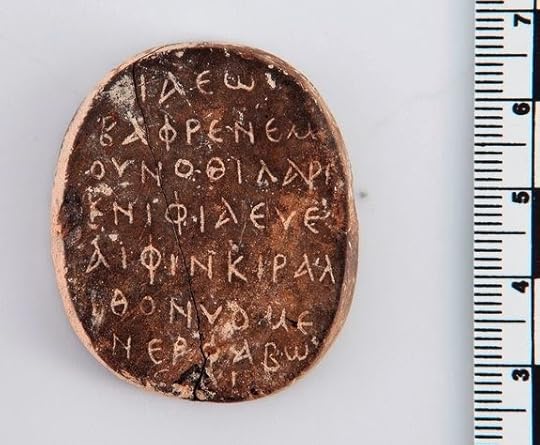 by Owen Jarus
by Owen JarusLive Science
The amulet contains a Greek inscription, 59 letters long, which reads the same backwards as it does forwards, a feature known as a palindrome. The three letters at the very bottom, ΕΑΙ, were squeezed in and are hard to read. The amulet is about 1.4 inches by 1.6 inches (34.9 millimeters by 41.2 millimeters) in size. The inscription translates as “Iahweh is the bearer of the secret name, the lion of Re secure in his shrine.” Although the translation doesn’t read as a palindrome, the original ancient Greek text does.
Credit: Photo by Marcin Iwan, artifact from the excavations of Jagiellonian University in Krakow at Paphos Agora
An ancient, two-sided amulet uncovered in Cyprus contains a 59-letter inscription that reads the same backwards as it does forwards.
Archaeologists discovered the amulet, which is roughly 1,500 years old, at the ancient city of Nea Paphos in southwest Cyprus.
One side of the amulet has several images, including a bandaged mummy (likely representing the Egyptian god Osiris) lying on a boat and an image of Harpocrates, the god of silence, who is shown sitting on a stool while holding his right hand up to his lips. Strangely, the amulet also displays a mythical dog-headed creature called a cynocephalus, which is shown holding a paw up to its lips, as if mimicking Harpocrates' gesture. [The 7 Most Mysterious Archaeological Finds on Earth] On the other side of the amulet is an inscription, written in Greek, that reads the same backwards as it does forwards, making it a palindrome. It reads:
ΙΑΕWΒΑΦΡΕΝΕΜ ΟΥΝΟΘΙΛΑΡΙ ΚΝΙΦΙΑΕΥΕ ΑΙΦΙΝΚΙΡΑΛ ΙΘΟΝΥΟΜΕ ΝΕΡΦΑΒWΕΑΙThis translates to "Iahweh(a god)is the bearer of the secret name, the lion of Re secure in his shrine."
Researchershave found similar palindromes elsewhere in the ancient world writes Joachim Śliwa, a professor at the Institute of Archaeology at Jagiellonian University in Kraków, Poland, in an article recently published in the journal Studies in Ancient Art and Civilization.
Śliwa notes that the scribe made two small mistakes when writing this palindrome, in two instances writing a "ρ" instead of "v."
The amulet was discovered in the summer of 2011 by archaeologists with the Paphos Agora Project. Led by Jagiellonian University professor Ewdoksia Papuci-Wladyka, this team is excavating an ancient agora at Nea Paphos, and uncovered this amulet during their work. Agoras served as gathering places in the ancient world.
Amulets like the one found at Nea Paphos were made to protect their owners from danger and harm, Papuci-Wladyka told Live Science in an email.
Christians and pagans
During the 5th and 6th centuries, Cyprus was part of the Eastern Roman Empire. The Roman Empire had split in two during the 4th century, with Cyprus falling under control of the east. When the Western Roman Empire fell during the 5th century, the Eastern Roman Empire continued to flourish and became what is sometimes called the Byzantine Empire.
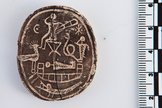 [image error]
[image error]
 The amulet has several images. At the bottom, there is a mummy (likely the Egyptian god Osiris) wrapped in bandages, lying on a boat. Above the mummy, there is an image of Harpocrates, a god of silence, shown sitting on a stool. Harpocrates’ right hand is raised up to his lips and there is a scepter in his left hand. To the right of Harpocrates there is a dog-headed creature called a cynocephalus that has a paw beside its lips, mimicking Harpocrates gesture. There is a snake between the cynocephalus and Harpocrates, the snake’s head facing Harpocrates. There are also depictions of a crocodile, bird (likely a rooster), half moon and a star.
The amulet has several images. At the bottom, there is a mummy (likely the Egyptian god Osiris) wrapped in bandages, lying on a boat. Above the mummy, there is an image of Harpocrates, a god of silence, shown sitting on a stool. Harpocrates’ right hand is raised up to his lips and there is a scepter in his left hand. To the right of Harpocrates there is a dog-headed creature called a cynocephalus that has a paw beside its lips, mimicking Harpocrates gesture. There is a snake between the cynocephalus and Harpocrates, the snake’s head facing Harpocrates. There are also depictions of a crocodile, bird (likely a rooster), half moon and a star. Credit: Photo by Marcin Iwan, artifact from the excavations of Jagiellonian University in Krakow at Paphos AgoraView full size imageBy the 5th century, Christianity was the official religion of the Eastern Roman Empire, and as time went on, traditional polytheistic (also called pagan) practices came under tighter restrictions and bans. Nevertheless, some people continued to practice the old beliefs, worshipping the traditional gods.
This amulet adds to evidence that people practiced traditional, polytheistic beliefs on Cyprus for an extended time, Papuci-Wladyka said. She notes that a structure called the Villa of Theseus has a mosaic with pagan elements that was likely repaired as late as the 7th century A.D.
It "rather seems that Christian and pagan religions coexisted in Paphos in times of [the] amulet being in use," Papuci-Wladyka told Live Science in an email.
Strange iconography
Despite that coexistence, the amulet has several unusual features that suggest its creator didn't fully understand the mythological characters depicted.
"It must be stated that the depiction is fairly unskilled and schematic. It is iconographically based on Egyptian sources, but these sources were not fully understood by the creator of the amulet," Śliwa wrote in the journal article.
For instance, rather than sitting on a stool, Harpocrates should be sitting on a lotus flower, with legs drawn up, Śliwa said. Additionally, the dog-headed cynocephalus should not be mimicking Harpocrates. In "the classic version, the cynocephalus faces Harpocrates with paws raised in adoration," Śliwa wrote."We can find no justification for the cynocephalus's gesture of raising its right paw to its lips in a manner similar to Harpocrates."
Even stranger is the fact that Harpocrates and the cynocephalus have crisscrossing lines on their bodies, which suggest the ancient artist thought these figures should be mummified along with Osiris. While the cynocephalus can be shown with mummy bandages, Harpocrates is not supposed to have them. Mummy bandages have "no justification in the case of Harpocrates," Śliwa wrote.
Published on January 03, 2015 14:43
History Trivia - Leonardo da Vinci unsuccessfully tests a flying machine.
January 3
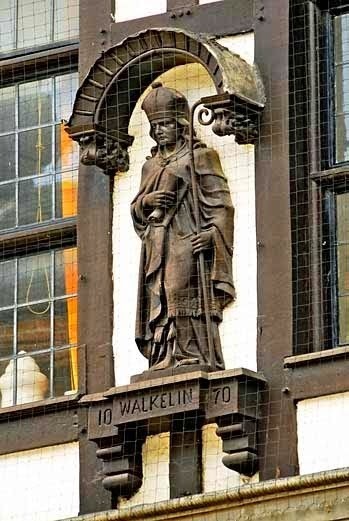
1098 Walkelin, first Norman bishop of Winchester, died.

1431 Joan of Arc was handed over to Bishop Pierre Cauchon. Legal proceedings began on 9 January 1431 at Rouen, the seat of the English occupation government where Joan was found guilty of heresy, and was burned at the stake on May 30.

1496 Leonardo da Vinci unsuccessfully tested a flying machine.

1521 Pope Leo X excommunicated Martin Luther, German theologian and Protestant reformer for heresy, in the papal bull Decet Romanum Pontificem.


1098 Walkelin, first Norman bishop of Winchester, died.

1431 Joan of Arc was handed over to Bishop Pierre Cauchon. Legal proceedings began on 9 January 1431 at Rouen, the seat of the English occupation government where Joan was found guilty of heresy, and was burned at the stake on May 30.

1496 Leonardo da Vinci unsuccessfully tested a flying machine.

1521 Pope Leo X excommunicated Martin Luther, German theologian and Protestant reformer for heresy, in the papal bull Decet Romanum Pontificem.

Published on January 03, 2015 03:00
January 2, 2015
History Trivia - The Alemanni invades the Roman Empire
January 2

366 The Alemanni crossed the frozen Rhine River in large numbers and invaded the Roman Empire.

533 Mercurius became Pope John II, the first pope to adopt a new name upon elevation to the papacy.

1492 Moorish Granada fell, completing the reconquest of Spain by Christian monarchs Ferdinand and Isabella.


366 The Alemanni crossed the frozen Rhine River in large numbers and invaded the Roman Empire.

533 Mercurius became Pope John II, the first pope to adopt a new name upon elevation to the papacy.

1492 Moorish Granada fell, completing the reconquest of Spain by Christian monarchs Ferdinand and Isabella.

Published on January 02, 2015 03:00
January 1, 2015
Did a Volcano Wipe Out the Neanderthals?
by Tia Ghose
Live Science
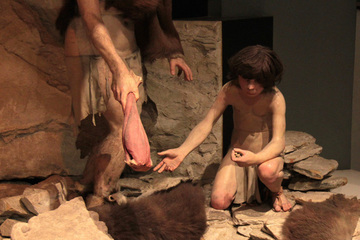 From an exhibit at the National Museum of Natural History, Washington DC, US.
From an exhibit at the National Museum of Natural History, Washington DC, US.
Credit: Flickr/Ricardo Giaviti, CC BY-NC-SA
A massive volcanic eruption about 40,000 years ago probably wasn't big enough to wipe out the Neanderthals as previous research suggested, new research finds.
Although the eruption, which occurred in what is now Italy, blanketed nearby areas in lava and ash, it wouldn't have lowered temperatures enough throughout Europe to be a significant cause of the Neanderthals' demise, said study co-author Benjamin Black, a geologist at the University of California at Berkeley.
Exactly why the Neanderthals disappeared is a mystery. "Neanderthal decline started well before the eruption, so if there were just a few scattered populations that were hanging on at the brink, it's hard to say what might have pushed them over the edge," Black told Live Science.
Long, slow decline
Neanderthals and modern humans diverged from a common ancestor about 500,000 years ago, and at its peak, the Neanderthal population numbered about 70,000. But the population slowly dwindled and Homo neanderthaliswent extinct between 35,000 and 41,000 years ago. Some scientists have proposed that humans killed off the rival hominins, while others say Neanderthals interbred with modern humans until the group was completely absorbed. [Top 10 Mysteries of the First Humans]
Another controversial theory has proposed that the Campanian Ignimbrite super-eruption about 40,000 years ago, near modern-day Naples, dramatically cooled the climate.
To test that theory, Black and his colleagues used existing data on rocks from the eruption and combined those with climate models. Their new model predicted how sulfur — which absorbs and scatters sunlight and can therefore cool the climate — was carried through the atmosphere over Europe after the eruption.
The team found that the climate would have cooled at most about 9 to 18 degrees Fahrenheit (5 to 10 degrees Celsius). This certainly would have been a cold snap, but such a temperature swing was still within range of what the Neanderthals would have routinely experienced.
What's more, Neanderthals were already extinct in Italy at that time, and the temperature change in other parts of Europe would have been even more modest, Black said.
The data suggests the eruption wasn't a major factor in the Neanderthals' extinction, Black said.
Case closed?
"I agree with the opinion that it would not have been cold enough after the Campanian Ignimbrite eruption to affect life seriously," Stephen Self, a volcanologist at the U.S.-Nuclear Regulatory Commission, who was not involved in the study, told Live Science an email.
But not everyone thinks the case is closed.
"It always strikes me as odd that scientists still keep looking for the one parameter/smoking gun to explain the story, when reality tells us that the impact of natural events is a combination of a series of complex events, and when the combination is unfavorable the effects can be big," Thorvaldur Thordarson, a volcanologist at the University of Iceland, told Live Science in an email.
For instance, the huge amounts of sulfur released in the eruption could also have altered air circulation patterns, meaning the climate models that are based on current circulation patterns might not tell the whole story of what happened during the eruption, said Thordarson, who was not involved in the new study.
Aside from providing insight into the demise of the Neanderthals, the new study could also shed light on our species' ability to adapt to changes in climate, Black said.
"It's kind of cool to think about this study as a way of understanding how resilient human beings are when their environment changes very suddenly, which is something that's happening right now," Black said. "The difference is that 40,000 years ago, anatomically modern humans did not have some of the luxuries that we have today."
The findings were presented Dec. 18 at the annual meeting of the American Geophysical Union in San Francisco.
Live Science
 From an exhibit at the National Museum of Natural History, Washington DC, US.
From an exhibit at the National Museum of Natural History, Washington DC, US.Credit: Flickr/Ricardo Giaviti, CC BY-NC-SA
A massive volcanic eruption about 40,000 years ago probably wasn't big enough to wipe out the Neanderthals as previous research suggested, new research finds.
Although the eruption, which occurred in what is now Italy, blanketed nearby areas in lava and ash, it wouldn't have lowered temperatures enough throughout Europe to be a significant cause of the Neanderthals' demise, said study co-author Benjamin Black, a geologist at the University of California at Berkeley.
Exactly why the Neanderthals disappeared is a mystery. "Neanderthal decline started well before the eruption, so if there were just a few scattered populations that were hanging on at the brink, it's hard to say what might have pushed them over the edge," Black told Live Science.
Long, slow decline
Neanderthals and modern humans diverged from a common ancestor about 500,000 years ago, and at its peak, the Neanderthal population numbered about 70,000. But the population slowly dwindled and Homo neanderthaliswent extinct between 35,000 and 41,000 years ago. Some scientists have proposed that humans killed off the rival hominins, while others say Neanderthals interbred with modern humans until the group was completely absorbed. [Top 10 Mysteries of the First Humans]
Another controversial theory has proposed that the Campanian Ignimbrite super-eruption about 40,000 years ago, near modern-day Naples, dramatically cooled the climate.
To test that theory, Black and his colleagues used existing data on rocks from the eruption and combined those with climate models. Their new model predicted how sulfur — which absorbs and scatters sunlight and can therefore cool the climate — was carried through the atmosphere over Europe after the eruption.
The team found that the climate would have cooled at most about 9 to 18 degrees Fahrenheit (5 to 10 degrees Celsius). This certainly would have been a cold snap, but such a temperature swing was still within range of what the Neanderthals would have routinely experienced.
What's more, Neanderthals were already extinct in Italy at that time, and the temperature change in other parts of Europe would have been even more modest, Black said.
The data suggests the eruption wasn't a major factor in the Neanderthals' extinction, Black said.
Case closed?
"I agree with the opinion that it would not have been cold enough after the Campanian Ignimbrite eruption to affect life seriously," Stephen Self, a volcanologist at the U.S.-Nuclear Regulatory Commission, who was not involved in the study, told Live Science an email.
But not everyone thinks the case is closed.
"It always strikes me as odd that scientists still keep looking for the one parameter/smoking gun to explain the story, when reality tells us that the impact of natural events is a combination of a series of complex events, and when the combination is unfavorable the effects can be big," Thorvaldur Thordarson, a volcanologist at the University of Iceland, told Live Science in an email.
For instance, the huge amounts of sulfur released in the eruption could also have altered air circulation patterns, meaning the climate models that are based on current circulation patterns might not tell the whole story of what happened during the eruption, said Thordarson, who was not involved in the new study.
Aside from providing insight into the demise of the Neanderthals, the new study could also shed light on our species' ability to adapt to changes in climate, Black said.
"It's kind of cool to think about this study as a way of understanding how resilient human beings are when their environment changes very suddenly, which is something that's happening right now," Black said. "The difference is that 40,000 years ago, anatomically modern humans did not have some of the luxuries that we have today."
The findings were presented Dec. 18 at the annual meeting of the American Geophysical Union in San Francisco.
Published on January 01, 2015 07:35
Happy New Year

Wishing everyone a very Happy New Year.
I am grateful for your support and interest in my work.
God bless.
Mary Ann Bernal

Published on January 01, 2015 04:30
History Trivia - Last gladiator competition in Rome
January 1

45 BC Julius Caesar's calendar reform: 365 days in 12 months with leap years every four years was introduced.

43 BC Cicero delivered his Fifth Philippic (fifth of a series of speeches condemning Mark Antony) in the Roman Senate.

27 BC Octavian became the first emperor of Rome and took the name Caesar Augustus.
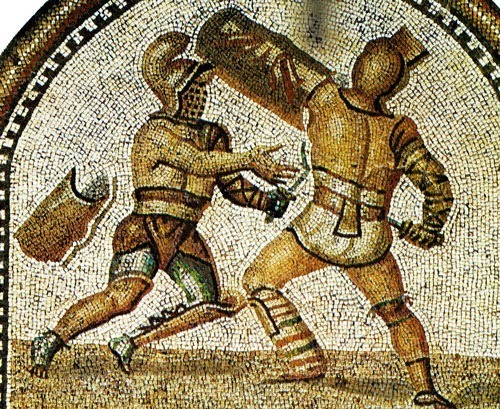
404 Last gladiator competition in Rome.

1431 Pope Alexander VI (Rodrigo Borgia) was born.


45 BC Julius Caesar's calendar reform: 365 days in 12 months with leap years every four years was introduced.

43 BC Cicero delivered his Fifth Philippic (fifth of a series of speeches condemning Mark Antony) in the Roman Senate.

27 BC Octavian became the first emperor of Rome and took the name Caesar Augustus.

404 Last gladiator competition in Rome.

1431 Pope Alexander VI (Rodrigo Borgia) was born.

Published on January 01, 2015 03:30



